Nick Mantegna, a fourth year UBC Forestry student recently collaborated with Garden Associate Director Dr. Tara Moreau on a UBC SEEDS project to explore how UBC campus spaces can improve resiliency and biodiversity through biomimicry—the practice of applying nature’s design to sustainably solve human design challenges.
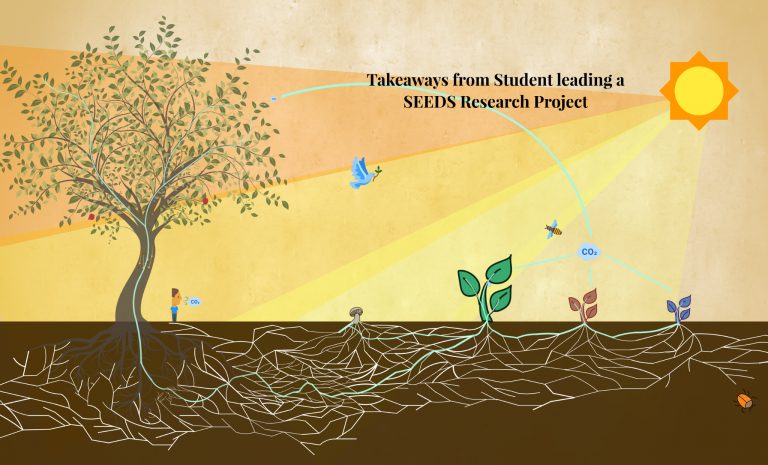
Nature is in a constant state of change. Trees sway in the wind, gathering light energy with their leaves and water with their roots. Animals such as birds help disperse seeds, and mycorrhizal fungi transport water, carbon and essential nutrients underground so that plants can communicate with one another. The result of these diverse relationships are the necessary components of human life on earth, such as fresh air to breathe and clean water to drink.
Situated on the traditional, ancestral, and unceded territory of the Musqueam people, the UBC Vancouver campus is full of biodiversity that attracts students from all around the world. Biodiversity has been rapidly declining over the past century, partially because the value of biodiversity has been poorly understood by western culture. Institutions such as UBC are seeking to understand how to prevent biodiversity loss on campus and worldwide.
As part of UBC’s climate action response, the funding for this research project was aimed at exploring how the emerging themes of ecological connectivity and biomimicry can help UBC understand how to respond to the climate crises.
-
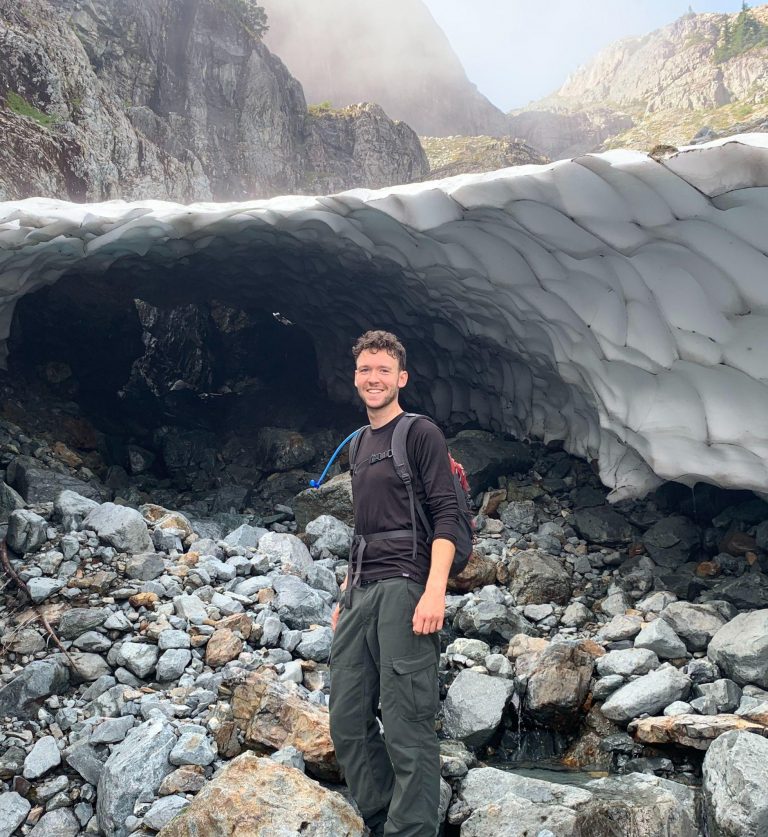
That’s me, on my way to the peak of a mountain near Squamish, B.C. I feel the happiest when I am exploring in the mountains.
I was fortunate enough to receive funding to take on the role of student leader for a SEEDS (Social Ecological Economic Development Studies) Sustainability Program research project in the winter of 2021. SEEDS is an internationally recognized program that provides exciting opportunities for students to mobilize research into action and advance social, ecological and economic sustainability through impactful collaborations between students, faculty, staff and community members.
My background as an Urban Forestry undergraduate student in the Faculty of Forestry at UBC as well as my experience volunteering for a SEEDS project over the previous summer (that project mapped the UBC campus landscape change overtime) are two factors that qualified me for leading this research project.
One of the main objectives for the research project is to create a tool that can help UBC Campus and Community Planning understand the areas of high and low ecological connectivity on the UBC campus. The second main objective is to research the concept of biomimicry and apply relevant findings to help find solutions to our climate and ecological crisis.
Biomimicry and Campus Planning
“Biomimics tend to ask: what can humans learn from ancient organisms, so that we can solve human problems that other species have solved such as living sustainably with nature?
A tree is intimately attached to its local area and has no choice but to converse with its immediate surroundings. In order to increase the chances of survival for generations to come, the tree creates conditions conducive to more life by providing habitat for a diversity of species above and below ground.
Biomimicry examines what structures and functions have allowed life to flourish for the past 3.8 billion years. Biomimics tend to ask: what can humans learn from ancient organisms, so that we can solve human problems that other species have solved such as living sustainably with nature?
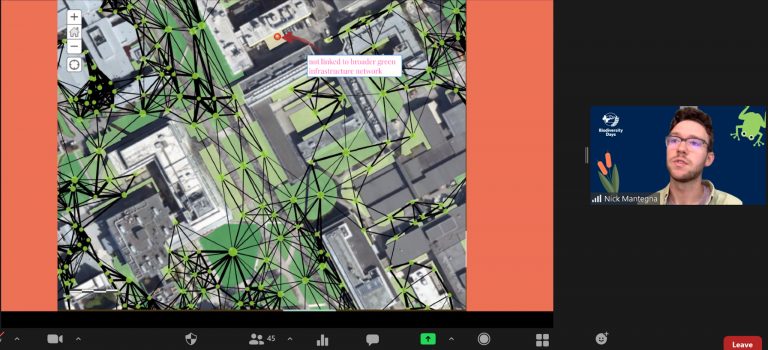
Zoom presentation on networks of existing ecological connectivity of the UBC campus. Courtesy of Laura Arango (SEEDS Applied Research Coordinator).
In May 2021, I participated in the UBC Biodiversity and Climate Action Ideas Showcase in which I presented a web map tool that is useful for understanding the existing ecological connectivity of the UBC campus.
The green polygons you see in the figure above are soft landscapes on the UBC campus. A soft landscape is basically any plant or collection of plants in a defined area.
Given that almost every species on earth is influenced by its immediate surroundings, the node and link network I discussed over Zoom is a map of the structural ecological connectivity of the UBC campus. The connections are based on the spatial proximity of one soft landscape to all other soft landscapes within 10 meters.
The branching and grouping structure you see on parts of the web map is a common structure of an organism that lives quietly below our feet.
“What can UBC learn from mycorrhizal networks that can be applied to increase the resilience of the UBC green infrastructure network?”
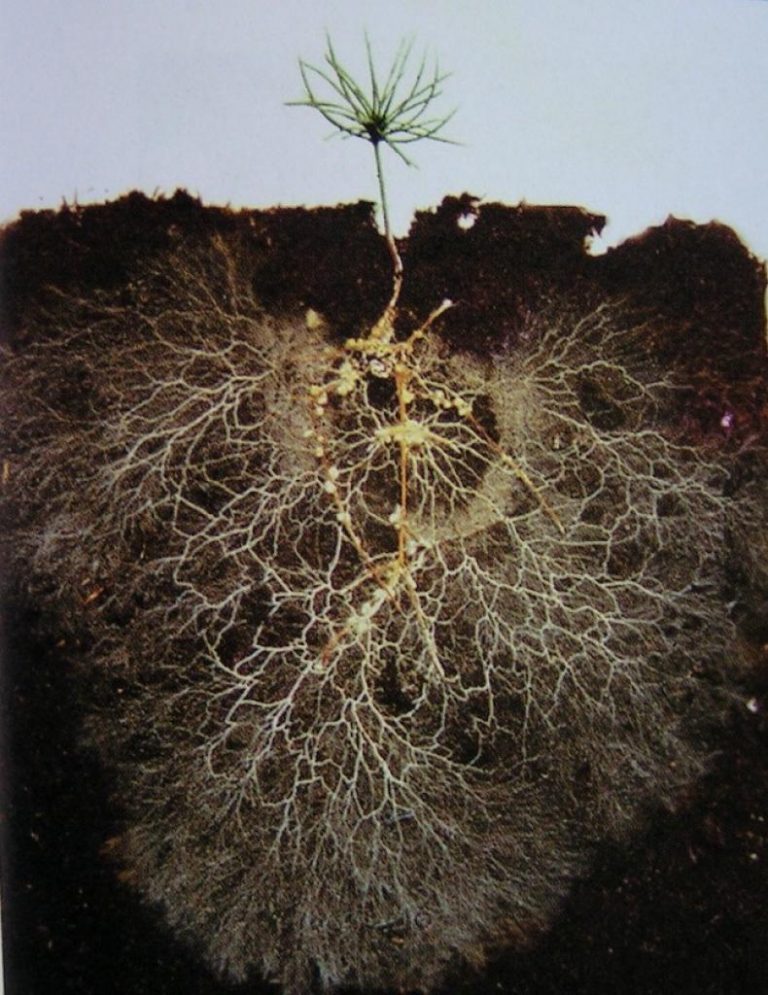
Mycorrhizal network. Courtesy of Sir David Read (author of textbook titled: Mycorrhizal Symbiosis).
Mycorrhizal fungi have been busy connecting trees underground with their white threadlike mycelium for hundreds of millions of years. Mycorrhizae facilitate underground communication within plant communities. The connectivity that the mycorrhizae provide for a forest allow for the community to become more resilient to disturbances such as drought or disease because the mycorrhizae help trees to send signals to one another and share resources through the fungal mycelium.
The biomimicry section of this SEEDS report asks, “What can UBC learn from mycorrhizal networks that can be applied to increase the resilience of the UBC green infrastructure network?”
Hundreds, sometimes thousands, of different species of mycorrhizal fungi can connect with a host tree. All of these species of mycorrhizal fungi manage to coexist with the host tree.
When a tree is given enough time to form a diversity of mycorrhizal associations, the mycorrhizae often self-assemble into groups of fungal species called modules. Think of this vast community of mycorrhizal fungi species associated with a host tree as a network in which each fungal species has the capacity to interact with other members of the mycorrhizal fungi community.
Researchers have recently analyzed the network of mycorrhizal fungi associations with a host tree and found that the assemblage commonly displays a network pattern called “modularity”(Montesinos-Navarro, 2012).
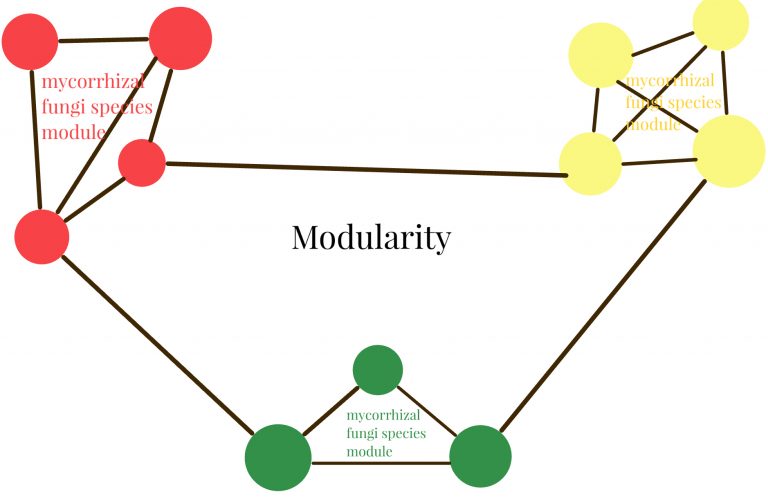
Diagram of a network that shows modularity. Each group of nodes and links is called a module.
In the simplified example network in the image above, each of these groups of nodes and links is called a module. A network with a high degree of modularity is self-assembled into interconnected communities in which the number of connections within a group is maximized and the number of connections between groups is minimized.
A network with a high degree of modularity is resilient because it is more likely than a non-modular network to continue functioning after a shock to the system. The expression of modularity found within mycorrhizal networks can apply to Landscape Design and Planning practices. In order to make progress towards climate change resilience objectives, UBC could modify their green infrastructure network so that soft landscape network modularity is increased.
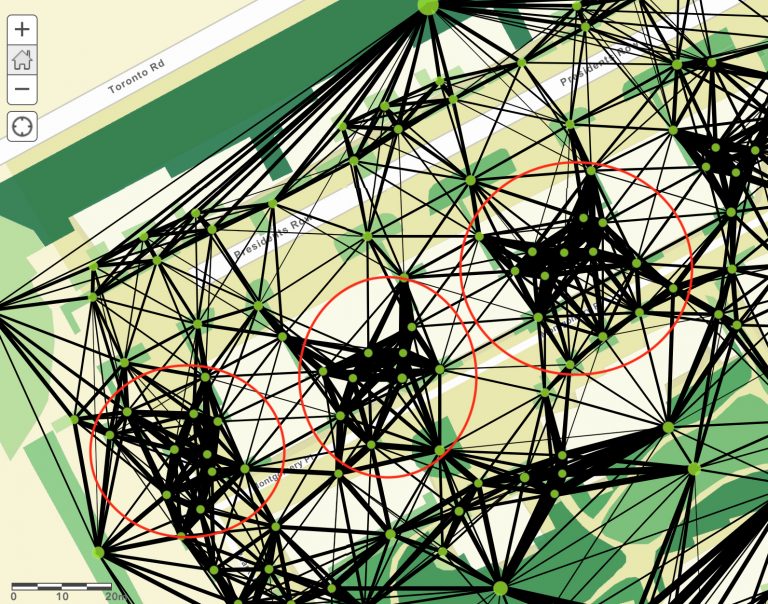
Screenshot from web map tool showing a space in camps with three hubs of nodes with high modularity.
When we start mapping our soft landscapes on the UBC campus as proximity-based networks, areas of high and low modularity are revealed. The figure above is a screenshot from the web map tool with the map extent showing an area of east campus. The three hubs of nodes and links circled in red are examples of soft landscape groups that display a high degree of modularity.
“By implementing this soft landscape communities design strategy at the UBC campus, it is more likely that urban forests of UBC will be equipped to withstand local climate change impacts such as rising temperatures, extreme weather events and biodiversity loss.”
Given that previous research has demonstrated that the fungal species diversity of plant-mycorrhizal interactions displays a high degree of modularity, UBC could modify their green infrastructure network so that there are more modular communities of soft landscapes on campus similar to the figure above. The soft landscape communities would mimic the modular design of a mycorrhizal network. By implementing this soft landscape communities design strategy at the UBC campus, it is more likely that urban forests of UBC will be equipped to withstand local climate change impacts such as rising temperatures, extreme weather events and biodiversity loss.
Potential Solution: Green Corridors
When we consider what modifications we can make to increase urban forest cover of the UBC campus, it is important to understand the pressures to build grey infrastructure on campus. These pressures limit the extent to which ecological connectivity can be integrated with the UBC campus.
Green corridors are an example of a biophilic design element that Campus and Community Planners can implement to increase the ecological connectivity of campus while leaving room for grey infrastructure.
A green corridor is often thought of as a thin strip of soft landscape that can facilitate the movement of wildlife. Green corridors are an easy biophilic design element to implement mostly because the size and shape of a green corridor can be manipulated to fit within the surrounding environment.
Even a tiny green corridor can have profound effects on ecological connectivity: it can act as a node and link within the green infrastructure network that can help increase modularity. The green corridor can take the form of a stepping stone or bridge that can connect two ecological communities that were previously isolated.
A large piece of the final SEEDS report involved framing recommendations to campus planners and designers. With time, I managed to link my soft landscape communities design strategy to priority issues that UBC currently faces, such as stormwater management. For example, green corridors can help mitigate the stormwater discharge of the UBC campus, by acting as bioswales, which decrease stormwater runoff. The full report examines how UBC policies such as The Green Building Action Plan, Climate Action Plan, and Bird Friendly Design Guidelines can be informed by such research findings.
Key Takeaways from the Project
When I reflect on my experience with this SEEDS Project, I learned that the key to being a successful leader involves facilitating members of the research team to contribute to the overall project, so that each individual can play to their strengths. I recognized that it is my responsibility to gain knowledge and recommendations from members of the research team, then integrate that knowledge in a manner that aligns with the shared vision of the project.
Many of the most beneficial outcomes of this research project were not my original idea-rather it was my job to put together the input from the team members into a cohesive whole that aligns with my intended direction for the research project. For example, during the initial stages of the project before I decided on how I wanted to measure ecological connectivity, I had a couple of Zoom meetings with Paul Pickell, a Faculty of Forestry Assistant Professor with GIS expertise. Pickell recommended that by buffering the soft landscapes on the UBC campus, the number of intersecting buffers could be analyzed to represent structural ecological connectivity.
I listened to Pickell’s advice, then decided that I would use his idea as the foundation for visualizing the gradient of high and low ecological connectivity on the UBC campus. Collaborating with Pickell taught me the importance of keeping an open mind so that I can absorb ideas that I would never have thought of on my own if I did not welcome input from outside my patterns of thought.
One of my career goals is to help blur the imaginary line between the human built environment and the natural world. I believe that perceiving our urban areas as a space that blends nature with human creation can facilitate the necessary innovation that we need to live sustainably with nature.
One of the goals of the web map tool showcased in this SEEDS report is to have the reader start to think of urban greenspaces as full of diverse species that are constantly interacting with one another. Our urban forests are under threat from climate change and grey infrastructure development pressures. Designing our urban forests in the future as modular communities can help urban biodiversity adapt to climate change.
Please view the full research report, including acknowledgments and references, below.
Submitted by: Nick Mantegna, fourth year UBC Forestry student
